
98
| Journal of Science and Technology in Medicine and Pharmacy | Vol 2, No 5 - 2023
Editor-in-Chief:
Dr. Nguyen Phuong Sinh
Received:
10/8/2023
Accepted:
10/11/2023
Published:
31/12/2023
Copyright: @ 2023
Belongs to the Journal of
Science and Technology in
Medicine and Pharmacy
Competing interests: The
authors have no competing
interests to declare.
Contact address: No. 284,
Luong Ngoc Quyen str., Thai
Nguyen city, Thai Nguyen
Province
Email:
tapchi@tnmc.edu.vn
EPIDEMIOLOGICAL, CLINICAL AND LABORATORY
CHARACTERISTICS OF HAND, FOOT AND MOUTH
DISEASE IN CHILDREN AT PHU THO OBSTETRICS
AND PEDIATRICS HOSPITAL
Ha Son Tung 1, Be Ha Thanh2*, Nguyen Van Son2
1 Phu Tho Obstetric and Pediatric Hospital
2 Thai Nguyen University of Medicine and Pharmacy
* Author contact: behathanh@tump.edu.vn
ABSTRACT
Background: Hand, foot and mouth disease is contagious illness
transmitted from person to person, often leading to outbreaks,
caused by enteric viruses. Objective: Describing some
epidemiological, clinical, and laboratory characteristics of hand,
foot and mouth disease in children. Methods: Cross-sectional
descriptive study, with 207 children diagnosed with hand, foot,
and mouth disease at Phu Tho Obstetrics and Pediatrics Hospital,
from September 2022 to May 2023. Results: The average age
was 22 ± 13 months, the highest group was 12-23 months with
53.1%. The male/female ratio was 1.3/1. The majority of infected
children had contact with a source of infection in the 7 days
before getting sick, accounting for 65.7%, went to kindergarten,
accounting for 55.1%, and lived in rural areas accounting for
57%. Children without malnutrition have the highest disease
incidence from January to March and malnourished children have
the highest incidence from October to December (p < 0.05). High
fever ≥ 39 degrees is related to children < 3 years old and have a
positive Enterovirus 71 rapid test. The proportion of children
with severe severity accounts for 15%. Increased C-reactive
protein is common in patients with malnutrition and severe
patients. Conclusions: Hand, foot, and mouth disease is common
in children aged 12-23 months, those who come into contact with
infectious sources and go to kindergarten have a higher incidence
of the disease. High fever is associated with children < 3 years
old and with a positive Enterovirus 71 rapid test.
Keywords: Hand, foot and mouth disease; Children;
Epidemiological; Clinical.

Journal of Science and Technology in Medicine and Pharmacy | Vol 2, No 5 - 2023 |
99
INTRODUCTION
Hand, foot and mouth disease (HFMD) is contagious illness
transmitted from person to person, often leading to outbreaks,
caused by enteric viruses. This disease can occur at all ages but is
most common in children under 5 years old, especially those
under 3 years old. The two main groups of agents causing the
disease that are commonly encountered are: Coxsackie virus A16
(CV-A16) and Enterovirus 71 (EV71). In 2009, there was a
HFMD outbreak in China with 1.155.525 reported cases, 13.810
severe cases, and 353 deaths. Subsequent outbreaks have been
reported in other countries as well. In Vietnam, the first HFMD
case was reported in 2003 and in the following years the disease
has been reported in all major provinces and cities across the
country. Data from the Ministry of Health indicates an increasing
trend in the number of case in recent years, with the peak being in
2011 when Vietnam recorded 113.121 HFMD cases and 170
deaths1.
The characteristics of HFMD in children vary significantly by
geographic region, both within countries and worldwide. A study
on the characteristics of HFMD in children at Saint Paul Hospital
in Hanoi (2020 – 2021)2 showed that it was more common in
males than females, mouth ulcers and skin rashes were observed
in all pediatric patients, with a high proportion (70%)
experiencing moderate to severe disease (Grade 2b – 4) and
positive PCR test for EV71 was 28.8%. All the while, another
study in Tien Giang (2015 – 2019), the positive PCR rate of
severe disease at 0.3%3; in China (2016 – 2018), the positive PCR
rate for EV71 was 8.9%, and for CV-A16 was 5.2%, with an
overall rate of severe disease of 16.4% and for the EV71 –
positive group was 47.7%4. So, what are the differences in the
characteristics of HFME in children in Phu Tho province?
Therefore, we conducted this study with the aim of “Describing
some epidemiological, clinical, and laboratory characteristics of
hand, foot and mouth disease in children treated at Phu Tho
Obstetric and Pediatric Hospital in 2022 – 2023”.
METHODS
Participants, time and location of study: 207 children with
HFMD were treated inpatients at Phu Tho Obstetrics and

100
| Journal of Science and Technology in Medicine and Pharmacy | Vol 2, No 5 - 2023
Pediatrics Hospital from September 2022 to May 2023, meeting
the criteria.
Inclusion criteria:
The clinical diagnosis of HFMD was made according to the
definition provided by the Ministry of Health5, based on:
- Epidemiological factors: based on age, season, and disease
prevalence in the region.
- Clinical symptoms: typical blistering on the mouth, palms, soles,
knees, and buttocks, with or without fever.
Patients aged 15 and lower were tested rapid EV71 testing.
The family of child agreed to participate in the study.
Exclusion criteria: Children with pre-existing dermatological
conditions, liver diseases, or blood cotting disorders before
contracting HFMD.
Methods
Study design: Cross-sectional descriptive study.
Sample size: Applying the sample size formula for estimating the
proportion:
p (1-p)
n = Z2(1-α/2)
d2
In which:
n: the required sample size for the study.
Z2(1-α/2) is the confidence level taken at the threshold α = 0.05. We
have Z2(1-α/2) = 1.96
p = 0.892; the proportion of mouth ulcers in HFMD patients in the
study by Do Quang Thanh, 20226.
d: absolute precision requires, in this study, taking d = 0,05.
According to this formula, the minimum required sample size is:
N = 148,03.
Sampling techniques in research: Convenient sampling,
selecting all eligible patients to include in the study.
Our study collected 207 patients, meeting the sample size formula
above.
Research variables, indicator:

Journal of Science and Technology in Medicine and Pharmacy | Vol 2, No 5 - 2023 |
101
Epidemiological characteristics: Age in months (< 12, 12-23, 24-
35, 36-47, 48-59, ≥ 60 months), gender, place of residence (urban,
rural area), exclusive breastfeeding status for the first 6 months,
malnutrition – including mild malnutrition, stunting, and wasting,
attendance at daycare before the onset of disease, exposure to a
source of infection in the 7 days before falling ill, month of
illness, and educational level of the primary caregiver (completed
high school, less than high school)2.
Clinical characteristics: date of illness onset, systemic symptoms
(mouth ulcers, skin rashes, fever), neurological symptoms
(startling during examination or while asleep, seizures), high fever
≥ 39o C, disease severity (mild: Grade 1-2a, severe: Grade 2b-4)5.
Laboratory characteristics: EV71 viral infection hemotological
parameters (white blood cell count, platelet count), biochemical
parameters (GOT, GPT, C-reactive protein).
Data collection methods: The research team directly collected
data through interviews, patient examinations, and extraction from
patient medical records using the research, medical record
template that was developed. The EV71 virus was tested using the
SD BIOLINE rapid test to detect IgM antibodies against EV71 in
serum/plasma at the testing center of Phu Tho Obstertric and
Pediatric Hospital, with results available from 15 to 20 minutes.
Data collection for the research was condcuted from September
2022 to May 2023.
Data analysis: Using SPSS 22.0 software, calculate the frequency
and percentage (%) (for qualitative variables); mean, and standard
deviation (for quantitative variables). Comparing two proportions
using the Chi-square test, statistical significance is considered
when p < 0.05.
Research ethics: The research was conducted with the approval
of the Ethics Council of the University of Medicine - Thai
Nguyen University and Phu Tho Obstetric and Pediatric Hospital.
RESULTS
A study of 207 childrenwith HFMD identified the following
common characteristics:

102
| Journal of Science and Technology in Medicine and Pharmacy | Vol 2, No 5 - 2023
Table 1. Characteristics of children with HFMD
Characteristics (n=207)
n
%
Ages (months)
< 12
7
3.3
12 - 23
110
53.1
24 - 35
43
20.8
36 - 47
28
13.5
48 - 59
12
6.0
≥ 60
7
3.3
Mean (min - max)
22 ± 13 (3 - 79)
Gender
Male
117
56.5
Female
90
43.5
male-to-female ratio
1.3/1
The average age of the 207 children with (HFMD) is 22 ± 13
months, Most children with hand, foot, and mouth disease are
between the ages of 12-23 months accounting for 53.1% of cases.
The number of male patients was higher than females, with a
male-to-female ratio was 1.3/1 (Table 1).
Table 2. Epidemiological characteristics of HFMD (n=207)
Characteristics
n
%
Date of illnes onste
Days 1 – 2
124
59.6
Day 3 onwards
83
40.1
Place of residence
Urban
89
43
Rural
118
57
Educational background of
the caregiver
Below 12th grade
68
32.9
Graduated from 12th grade
139
67.1
Contact with a source of
infection within the last 7
days
Yes
136
65.7
No
71
34.3
Attendance at kindgarden
Yes
114
55.1
No
93
44.9
Exclusive breastfeeding for
the first 6 months
Yes
126
60.9
No
81
39.1





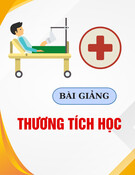





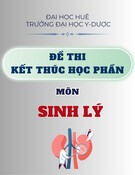

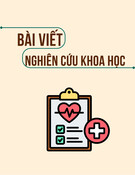
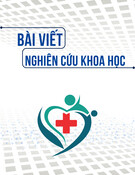

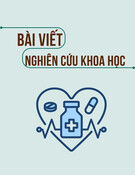

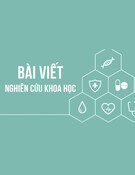
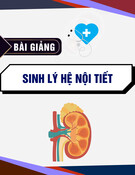


![Bài giảng Cập nhật vấn đề hồi sức bệnh tay chân miệng nặng [mới nhất]](https://cdn.tailieu.vn/images/document/thumbnail/2025/20250920/hmn03091998@gmail.com/135x160/23301758514697.jpg)



